
A pattern has formed in the late winter and spring, as the Forgotten NY camera has been stalking around lower Manhattan, especially Soho, the Lower East Side, and Chinatown, as I have been in the mood to snap older buildings and busy signage new and old. I like the wilderness, the waterfront and the You’d Never Believe You’re in NYC moments (see the FNY category) as much as the next guy but I suppose I have been on an ultra-urban kick, which means I have to dodge the motorized delivery go-karts that have become so ubiquitous in the age of Covid. At least they aren’t drones, which I think would lead to real problems.
The mood struck to re-walk Prince Street, which I did way back in 2012 after, get this, emerging from an interview at Scholastic. Back then interviews were still mostly in-person and I had my interview suit and tie on to boot. But I carry the camera everywhere and despite the dead dog humidity, down Prince I went and a satisfying walk it was. The street runs through the Sullivan-Thompson and Soho Cast-Iron Historic Districts (found on this handy map) and thus the buildings are well-documented, but I’ve been trying to shorten the weekly longform page and I won’t quote from them too heavily. This time I walked west to east, unlike the previous time; east-west SoHo streets are numbered east to west, except for Houston, which has an east and west section divided by Broadway. Come to think of it I should revisit Houston, which I crosstowned back in 2005.
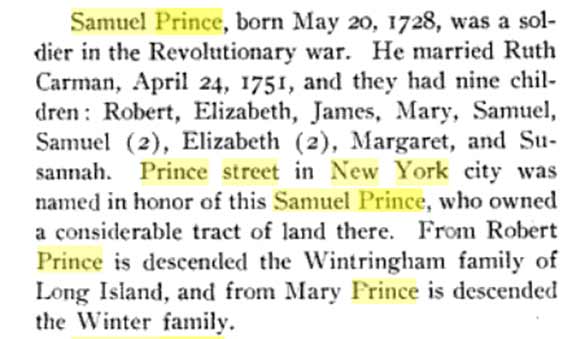
Both of the Manhattan “street books” in my possession by Sanna Feirstein and Henry Moscow claim that Prince Street is a leftover moniker from the British occupation of NYC that finally ended in 1783, but the above item that says otherwise is from the handy dandy “Historic Homes and Institutions and Genealogical and Personal Memoirs of the Lehigh Valley, Pennsylvania” by John Jordan of the Pennsylvania Historical Society, Edgar Green and George Ettinger (1905)

Father Fagan Square/Park was established in 1928 when 6th Avenue was extended south along the new IND Subway. The buildings on the left originally had Macdougal Street addresses, but were renumbered for 6th Avenue. Father Richard Fagan, a parish priest at St. Anthony’s, perished in a fire at the rectory in 1938 while saving the lives of two fellow priests. He was 27 years old.
Both #192 and #196 6th Avenue were originally on Macdougal Street, but became part of 6th Avenue; because of this, Macdougal’s house numbering begins at #34 north of Prince.
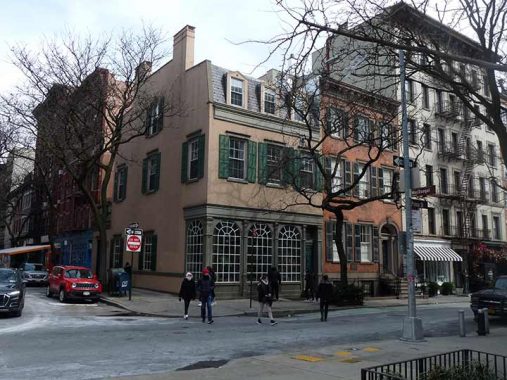
The prominent row house with the slanted roof, #205 (#34-36 Macdougal) on the corner was constructed in 1834 for John Haff. The roof, known as a mansard roof, was popular in the 1870s and was likely added around that time.
#203 Prince Street
is a 3-story brick residence combining Federal and Greek Revival styling and has been preserved, or more likely restored, to look the way it did when it was completed in 1834 for leather inspector John Haff. Here’s how it looked in 1940. Originally constructed with two stories, a third was added in 1888.
In the colonial period, this land was owned by vice president and murderer Aaron Burr, whose estate in what would be called SoHo and the West Village was called Richmond Hill; there are also regions of the same name in Queens and Staten Island (where Burr breathed his last in 1836). Burr occupies a unique niche in American history, patriot and villain all wrapped in one confusing whole.
The building was given NYC Landmarks designation in 1974, fairly early on because the Landmarks Preservation Commission was founded in 1965. According to Tom “Daytonian in Manhattan” Miller, the building has served as a parish house for the now-vanished Episcopal Church of Saint Ambrose and also as a funeral home; today it’s a quiet private residence.
St. Anthony of Padua convent at the SW corner of Prince and Sullivan is one of the newest buildings on Prince Street as it was built in 1955. The parish church it serves is a block away at Houston and Sullivan, a Romanesque Revival edifice that was constructed in 1888, with the parish itself established in the 1860s to serve Soho’s burgeoning Italian population. What was Soho called before the 1970s? Comments are open.
The tenement, now apartment building, catercorner to the parish hall was built in 1897. I have always liked the blackboard-like signage of the restaurant The Dutch, and look, the posted sidewalk menu has a lamppost on it.
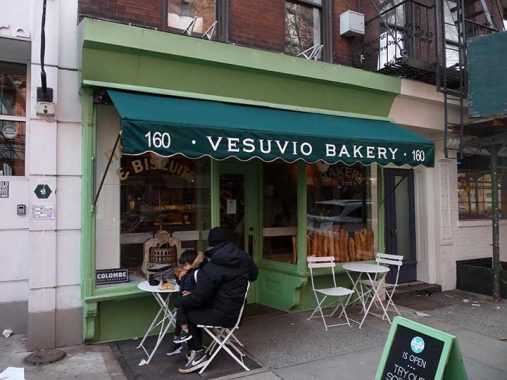
Vesuvio Bakery is at 160 Prince Street in SoHo. The green facade is one of the distinctive images and colors of downtown NYC which inhabitants would recognize immediately – the shade of blue-green is so striking that nearly everyone that sees the shop comments on the color. The bread is handmade daily and presented simply by being piled up in helplessly beautiful stacks in the windows. The shop is a fixture of the old Little Italy in NYC which has survived many generations, a tremendous feat in this city of constant change, and is still family-owned.
Recently, a few small tables and a wider variety of food have been added. This place became special by preserving itself on its own intimate terms while the neighborhood has gentrified exponentially around it. Seeing it is like taking a few seconds of a visual calming and restorative meditative break. [NY Daily Photo, 2006]
The bakery was a Soho institution between 1920 and 2008, and presented the same face to the neighborhood for decades — and still did, after its takeover by the City Bakery, which reopened it as Birdbath Bakery in 2009. Which reminds me, I was a frequent City Bakery visitor when I worked in the Flatiron district in 2013 and 2014 and was saddened to hear about its demise in 2019.
But there are happy endings! Vesuvio was reopened under its own name in 2020. I am going “keto” after a rising glucose count, so no bread for me! The object in the window at left is a dough-dividing machine.
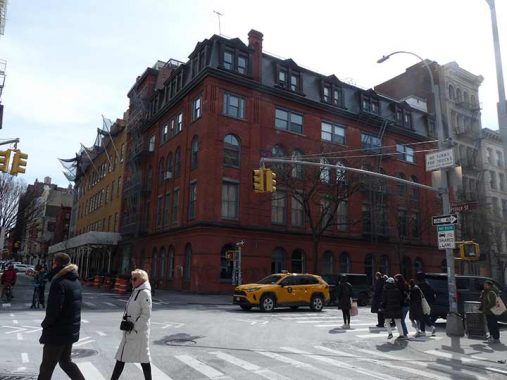
I was hoping to be able to say more about this massive brick building at #435 West Broadway at Prince, but the Landmarks report is curiously tightlipped about it, except to say it was built as a warehouse in 1879 with the first four stories, with the 5th added in the 1890s.
Owing to my brick factory fascination I always check on this lengthy building between Wooster and Greene Streets, actually three addresses from #120 to 124. A long time ago, the building had apparently been a paper distributor. A pair of metal signs that are, perhaps, over a century old can still be found there.
Manifold paper, in the days before Xerox and modern copy machines, was a lightweight paper used with carbon paper to make multiple copies. “Special forms”, as far as I gather, were used in tax preparation.
Engraving is the practice of incising a design on to a hard, usually flat surface, by cutting grooves into it. The result may be a decorated object in itself, as when silver, gold, steel, or glass are engraved, or may provide an intaglio printing plate, of copper or another metal, for printing images on paper as prints or illustrations. [wikipedia]
Lithography (the practice of drawing on limestone with waxy crayons to create a master image that absorbed ink) was introduced in the United States in the early 1800s … publishers used lithography as an inexpensive alternative to engraving and avoided the expense of multiple presses by lithographing both illustration and text. [Past is Present]
Modern computerized methods of printing may be more convenient, but we have certainly lost a sense of craft. Will this knowledge be available in future generations?

At 124 Prince is the Morrison Hotel Gallery (I believe there is another one at The Bowery and Bleecker). Its logo is reminiscent of The Doors’ classic Morrison Hotel LP cover. The band had propitiously found an actual Morrison Hotel at 1246 South Hope Street in Los Angeles. The actual Morrison Hotel closed in 2007.

This building at #103-107 Prince, corner of Greene, was built in 1910 as Post Office Station A, but for me, it’s always been where the magic happens–it was the first Apple Store in New York City. The Apple stores that have appeared since are high-concept glassy buildings, but for me this was the first and best. To this day, I still wander in and ogle the offerings, whether I am in the market for a new machine or not, but I also frequent the ones on 9th and 14th and in Grand Central Terminal, where I got a new IPhone battery last year.
One memorable day at this location was when I gave a presentation as part of a group of what were known as “NYC photobloggers,” though I don’t describe myself as strictly that. I met many fans of my work and I also met people of whom I’m fans, notably Matt Weber, the best street photographer in NYC. I showed some of my work and parried audience questions, some of which were skeptical, but I had a grand time and the host had to give me the high sign to wrap it up because the program had to move on.
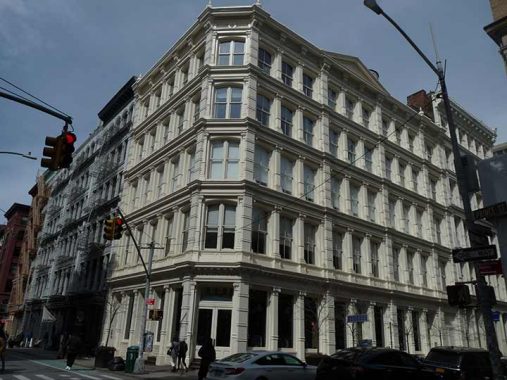
We’re in the center of the SoHo Castiron Landmarked District, with possibly the greatest concentration of cast iron front buildings in the country. From the 1850s to the 1890s, stone or brick buildings were given cast iron fronts to protect them from the elements, much like the less esthetic practice of aluminum siding in the 1950s and 1960s (for examples of that, visit Greenpoint and Williamsburg in Brooklyn). This building, #119 Greene Street at Prince, was built for merchant Jarvis Morgan Slade in 1883.
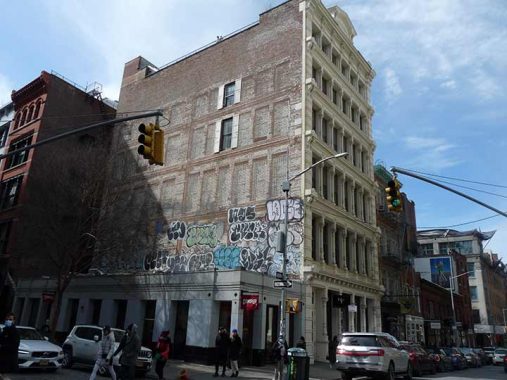
#112-114 Prince Street is a relatively late cast iron front constructed in 1882. Walking down Prince and in SoHo in general, it’s hard to believe that before the 1980s it was relatively rundown, with small manufacturers and businesses with just a few galleries, but later took off as a high rent area with expensive retail. The cat that many streets have kept their Beligian block pavement and there are still original castiron building fronts — and even a few early 1900s castiron lampposts — suggests that this area was overlooked for upkeep in NYC in the budget crises of the mid and late 1900s. Note the Richard Haas trompe l’oeil building front with two real windows (fading now, unfortunately) and the low building on the corner, built in 1966 before landmarking forbade any new construction.
Three separate institutions on the SW corner of Mercer and Prince: #94 Prince, Fanelli’s Cafe, and the neon Fanelli sign, which has seen generations of duty. 94 Prince, a 5-story brick building, looks a bit out of place next to its cast-iron front brethren — the building first appeared in 1857 when it was built by Herman Gerken, a German immigrant landowner. In both the previous wood building to occupy the site and the brick structure after, groceries were sold from a shop on the ground floor. At the time, alcoholic beverages including hard liquor were sold in general stores of this type. The rest of the building was divided among living and manufacturing space.
The ground floor continued to be used as both a place to buy liquor and as a tavern through a succession of owners beginning in 1863. A Nicholas Gerdes operated the tavern from 1878-1902, and his name remains inscribed in the transom over the front door; his liquor licenses decorate Fanelli’s walls. Michael Fanelli arrived in 1922 with Prohibition in full thrall, operating the place as a speakeasy until repeal. (The “café” name was first used during Prohibition to fool the coppers.) The Fanelli family owned the bar until 1982 when it was sold to Hans Noe.
(information from the late Richard McDermott, who has voluminously researched NYC’s venerable taverns, including Mc Sorley’s on East 7th Street. Another thorough description can be found in Ellen Williams & Steve Radlauer’s Historic Restaurants and Shops of New York)
I’ve been in Fanelli’s once and only once, in May 2006, and found the burger as good as advertised. The seating was a little cramped in the tight space, but the ambience made up for that slight inconvenience. This 1940 photo shows the neon sign in place, but the photographer shot it edge on, so you can’t tell what’s on it. (Back then the tax photographers weren’t esthetes.)
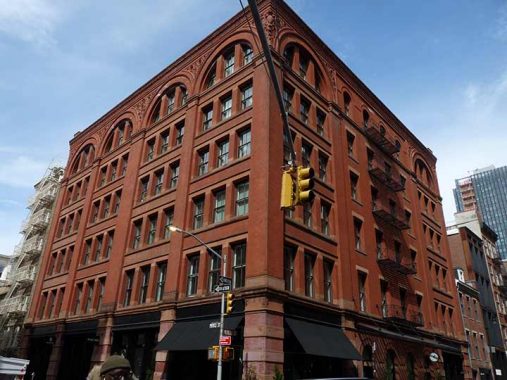
The late 1880s were great years for architecture (I find the Beaux Arts period that followed a bit excessive but still better than the ultrastreamlined trend that began after WWII and still plagues today). SoHo buildings that seem to be important buildings filled with offices were actually used for manufacturing, lofts and storage, as was this Romanesque building when it was built at 141-147 Mercer at the NW corner of Prince in 1888.
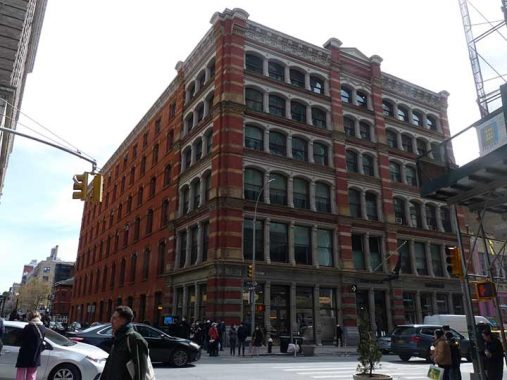
Another brick loft that’s so massive, it has three addresses and multiple doors: #74-78 Prince, #98-104 Crosby and #560-566 Broadway. It is now the flagship store of Converse sneakers, which put its name above the front entrance on Broadway.
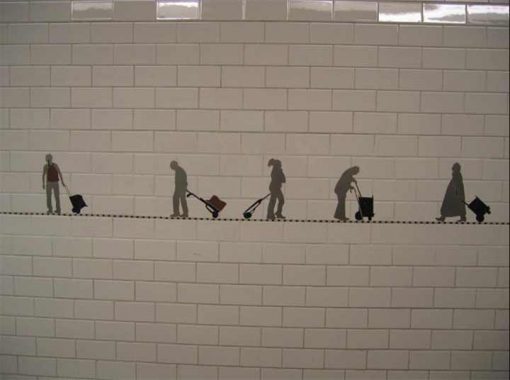

Beneath the intersection you find this artwork on the Prince Street station tiling on the Broadway Line (N, R and W trains) Prince street station wall. It was installed in 2004 as part of station renovations that took place in the late 1990s and early 2000s. Artist Janet Zweig describes it thusly:
The frieze at the Prince Street subway station celebrates the significance and individuality of the citizens of New York. … It depicts 194 silhouetted people … taken from photographs of New Yorkers in all their variety… arranged as a 1200 foot narrative that contains smaller dramatic narratives within it…. more than two thousand New Yorkers were photographed walking along the street… 194 were selected as the most evocative, varied, and visually readable…. For the installation, some of the existing white subway tiles were removed and replaced with new identical tiles that had been cut out in the shape of the figures … stainless steel, marble, and slate shapes were placed in those spaces like puzzle pieces, making it appear that the figures are embedded in the walls. The title, “Carrying On”, refers to the figures carrying various objects; New Yorkers carrying on with their lives after 9/11, and the “notoriously opinionated and lively” New Yorkers who “really do carry on.”
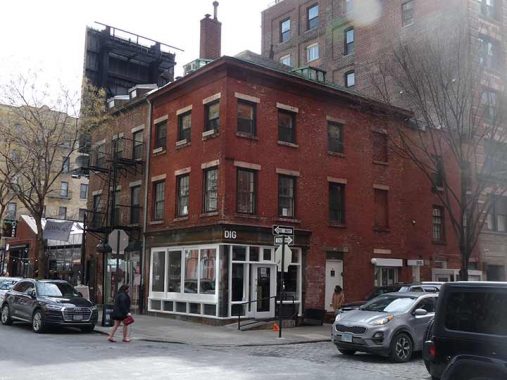
Speaking of saloons, #70 Prince Street at Crosby was built as a home by Patrick Sherryd in 1924 but in subsequent decades it was a tavern operated by Alderman Patrick Napoleon Oakley that got into trouble for selling demon rum on Sundays. Since then many restaurants have occupied the space including Back Forty West and Dig. The Essential Tom Miller of Daytonian in Manhattan has more.

On the northwest corner of Prince and Lafeyette, President James Monroe was staying in his sister’s house when he passed on July 4, 1831, following Presidents Adams and Jefferson, who died on July 4, 1826.
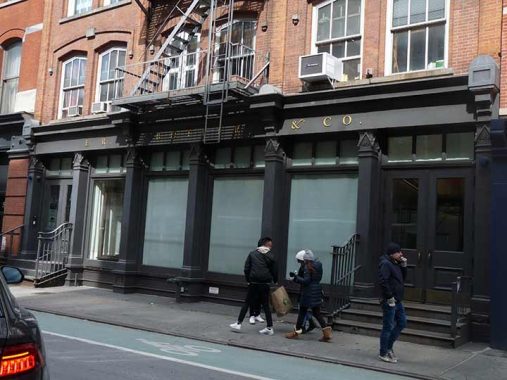
E.R. Butler is & Co., #55 Prince Street between Lafayette and Mulberry Streets, is a premium quality custom hardware manufacturer of fine architectural, builders’ and cabinetmakers’ Early American, Federal and Georgian period hardware for doors, windows and fine furniture. The website is carefully crafted with lots of company history, even though it was founded in 1950.
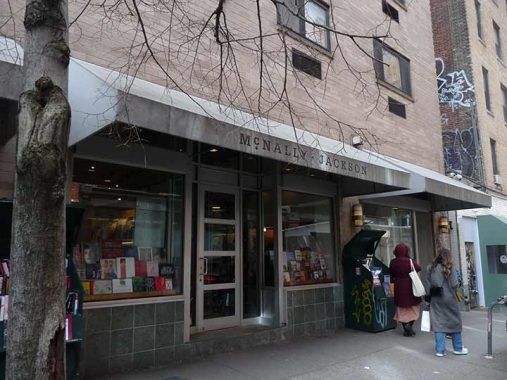
The McNally-Jackson bookstore was founded in 2008 by Sarah McNally and her husband Christopher Jackson; three more in what is now a burgeoning chain have opened. (Unfortunately I have never seen Forgotten New York The Book on the shelves, even when it opened in 2008, but maybe I’ve just been there at the wrong time.)
Old St. Patrick’s
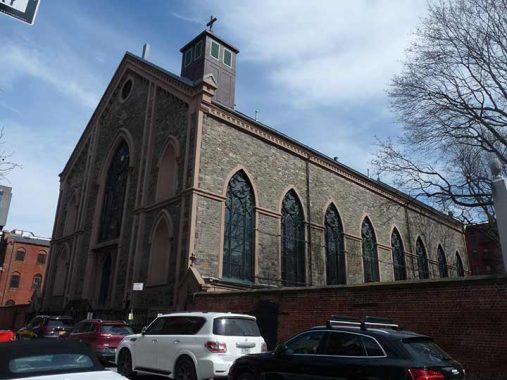
Old St. Patrick’s between Mulberry and Mott, one of NYC’s oldest churches. It’s called “old” to differentiate it from its “newer” cousin uptown, St. Patrick’s Cathedral at 5th Avenue and East 50th, designed by James Renwick Jr., opened 1878 and finished in 1888. Old St. Pat’s, NYC’s original Catholic cathedral, is quite a bit older, having started construction in 1809 and completed in 1815, making it one of the oldest buildings in Chinatown/Little Italy. In March 2010 Pope Benedict XVI announced that it would become Manhattan’s first basilica, a church that has been accorded certain specific and ceremonial rites only the Pope can bestow. In 2010, FNY detailed the church, so if you’re curious, I’ll direct you there.
Though the churchyard and its graves are gated off and inaccessible, I did manage a few shots over the gates. Among the burials are the Venerable Pierre Toussaint and Stephen Jumel, whose uptown mansion in Sugar Hill is Manhattan’s oldest remaining private residence. The catacombs are occasionally open to the public.
“Dagger John” Hughes, the first Archbishop of the Diocese of New York, was originally interred in the Old St. Patrick’s churchyard. Though his remains were moved uptown to the “new” St. Patrick’s at 5th Avenue, he is memorialized here. “He became known as ‘Dagger John,’ both for his following the Catholic practice wherein a bishop precedes his signature with a cross, as well as for his aggressive personality.”
For some interior views of Old St. Patrick’s, see the Newtown Pentacle.
More from Mulberry right here.
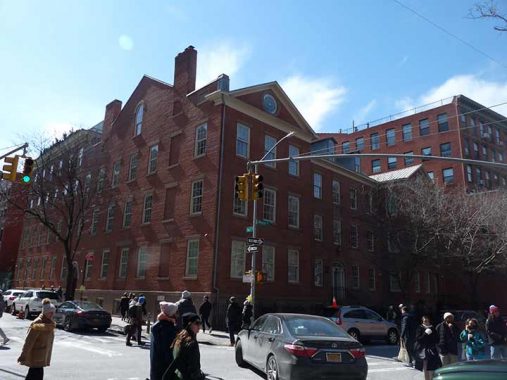
The massive building opposite the churchyard at Prince and Mott Streets is the as the Roman Catholic Orphan Asylum, completed in 1826, later the Old St Patrick’s Convent and Girls’ School and later a K-8 Catholic grade school. The school closed in June 2010 due to low enrollment, and is slated to be turned into luxury townhouses, condominiums, and office space.
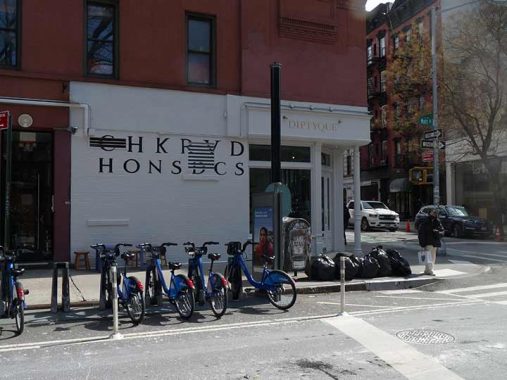
Diptyque is a luxury fragrances shop on the NE corner of Prince and Mott. I am not in the market for the moment but I’m stumped by what the lettering on the Mott Street side means. Comments are open.

I have to say something about this “wheat pasteup” on the mailbox in front to the perfume shop. I have long admired and coveted the serifed font used by Heinz on their ketchup and other food product labels. However, the company owns the font and does not offer it for sale. I wonder how the artist got it, or it may be a very similar replica font.
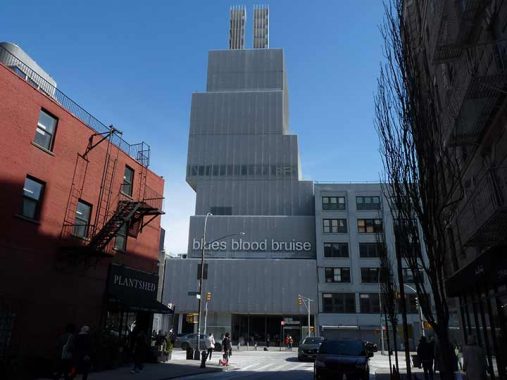
The New Museum of Contemporary Art, 235 Bowery opposite Prince Street. I have yet to visit the major new art museum, which opened its doors in 2007. It’s been uniformly praised by architecture critics and its designers, Kazuyo Sejima and Ryue Nishizawa, were chosen as 2010 laureates in the Pritzker competition, the biggest prize in the architecture game. Your webmaster, though, is a Philistine, and to me the building looks like 6 aluminum boxes stacked on top of the other, haphazardly. I’d have to go inside, though, to really pass judgment. The New Museum was founded in 1977.
Prizes aside, the place always reminded me of this old Monty Python sketch…
As always, “comment…as you see fit.” I earn a small payment when you click on any ad on the site.
5/29/22

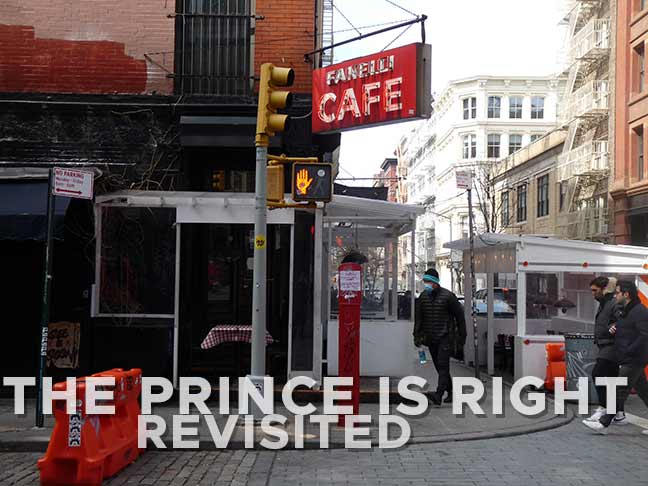
8 comments
James Monroe was one of four former presidents who died in the city. The others were Chester Arthur, Herbert Hoover and Richard Nixon.
The Roman Catholic Orphan Asylum is now seen on NBC’s “New Amsterdam” as a hospital, supposedly in London.
They tried calling it the “Cast Iron District” for awhile in the late 60s but it was
obviously too long so it never caught on.Before that I really doubt it had a name.
Loved walking through there as a kid in the 60s because it was so quiet and dark.
Like the Cabinet of Dr. Caligari
Before 1970 today’s Soho was sometimes called the Lower West Side, but in 1960 it acquired the moniker Hell’s Hundred Acres because of the frequency of fires in its old loft buildings. The NYC Fire Commissioner at the time, Edward Cavanaugh, appropriated the name from World War II conflicts. Link to full article: https://www.barrypopik.com/index.php/new_york_city/entry/hells_hundred_acres
435 West Broadway…a bit more…
West Broadway in this stretch used to be called South Fifth Avenue, and before that, Laurens Street. In its Lauren Street days (early to mid nineteenth century) the road was informally but widely known as Rotten Row, an allusion to the profusion of houses of prostitution there. In the 1850s-60s, this was brothel central.
Burr occupies a unique niche in American history, patriot and villain all wrapped in one confusing whole.
Gore Vidal may have had a similar opinion:
https://www.goodreads.com/book/show/8722.Burr
SoHo was also once known as the Valley, because the skyline takes a dip with its lower buildings compared to the tall skyscrapers further downtown and midtown to the north. It was also known as Hell’s Hundred Acres after several huge warehouse fires.
I was really hoping you might know the backstory of the cat sculpture in the window of #122. It’s been there as long as I can remember. It’s behind the white sign in the photo you posted so not visible but it’s there.
Also, next time you walk by #205 take a look through the grate in front of the house for a pleasant surprise.